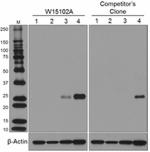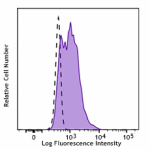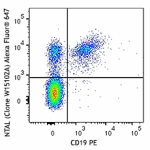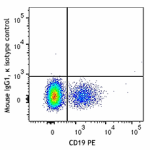- Clone
- W15102A (See other available formats)
- Regulatory Status
- RUO
- Other Names
- NTAL, LAT2, WBS15, LAB
- Isotype
- Mouse IgG1, κ
- Barcode Sequence
- ATCAGCCGAATCATG
| Cat # | Size | Price | Quantity Check Availability | ||
|---|---|---|---|---|---|
| 699009 | 10 µg | $369.00 | |||
Non-T cell activation linker (NTAL) functions as transmembrane adaptor scaffold that links engagement of antigen receptor binding to downstream effector molecules, playing an essential role in maturation, activation, and differentiation in various cell types. It is important for BCR (B-cell antigen receptor) and FCGR1 (high affinity immunoglobulin gamma Fc receptor I)-signaling in B-cells and myeloid cells, respectively, and plays a critical role in FCER1 (high affinity immunoglobulin epsilon receptor) signaling in mast cells. NTAL is encoded by the LAT2 gene, which is one of the contiguous genes at 7q11.23 commonly deleted in Williams syndrome.
Product Details
- Verified Reactivity
- Human
- Antibody Type
- Monoclonal
- Host Species
- Mouse
- Immunogen
- Partial human NTAL recombinant protein (27-243 a.a.) expressed in E. coli.
- Formulation
- Phosphate-buffered solution, pH 7.2, containing 0.09% sodium azide and EDTA
- Preparation
- The antibody was purified by chromatography and conjugated with TotalSeq™-B oligomer under optimal conditions.
- Concentration
- 0.5 mg/mL
- Storage & Handling
- The antibody solution should be stored undiluted between 2°C and 8°C. Do not freeze.
- Application
-
ICPG - Quality tested
- Recommended Usage
-
Each lot of this antibody is quality control tested by intracellular immunofluorescent staining with flow cytometric analysis and the oligomer sequence is confirmed by sequencing. TotalSeq™-B antibodies are compatible with 10x Genomics Single Cell Gene Expression Solutions.
To maximize performance, it is strongly recommended that the reagent be titrated for each application, and that you centrifuge the antibody dilution before adding to the cells at 14,000xg at 2 - 8°C for 10 minutes. Carefully pipette out the liquid avoiding the bottom of the tube and add to the cell suspension. For Proteogenomics analysis, the suggested starting amount of this reagent for titration is ≤ 0.5 µg per million cells in 100 µL volume. Refer to the corresponding TotalSeq™ protocol for specific staining instructions.
Buyer is solely responsible for determining whether Buyer has all intellectual property rights that are necessary for Buyer's intended uses of the BioLegend TotalSeq™ products. For example, for any technology platform Buyer uses with TotalSeq™, it is Buyer's sole responsibility to determine whether it has all necessary third party intellectual property rights to use that platform and TotalSeq™ with that platform. - Application Notes
-
This antibody does not cross-react with mouse NTAL (in-house tested). Daudi cells were selected for antibody testing due to the cell line’s low expression level of the mRNA encoding NTAL (source: Human Protein Atlas).
- Additional Product Notes
-
TotalSeq™ reagents are designed to profile protein levels at a single cell level following an optimized protocol similar to the CITE-seq workflow. A compatible single cell device (e.g. 10x Genomics Chromium System and Reagents) and sequencer (e.g. Illumina analyzers) are required. Please contact technical support for more information, or visit biolegend.com/totalseq.
The barcode flanking sequences are GTGACTGGAGTTCAGACGTGTGCTCTTCCGATCTNNNNNNNNNN (PCR handle), and NNNNNNNNNGCTTTAAGGCCGGTCCTAGC*A*A (capture sequence). N represents either randomly selected A, C, G, or T, and * indicates a phosphorothioated bond, to prevent nuclease degradation.
View more applications data for this product in our Scientific Poster Library. - RRID
-
AB_3068230 (BioLegend Cat. No. 699009)
Antigen Details
- Structure
- 243 amino acids with a predicted molecular weight of 26.5 kD, palmitoylation moiety permits localization to lipid rafts or tetraspanin-enriched microdomains.
- Distribution
-
Plasma membrane
- Function
- NTAL is extensively phosphorylated on multiple tyrosine residues following activation, enabling the protein to serve as a scaffold for multiple signaling complexes in various cell contexts. May also be post-translationally regulated by Caspase-3-mediated proteolytic cleavage in human B cells and monocytes.
- Interaction
- Phospholipase C gamma 1 and 2. When phosphorylated, interacts with GRB2. May also interact with SOS1, GAB1, and CBL.
- Biology Area
- Cell Biology, Signal Transduction
- Antigen References
-
1. Arbulo-Echevarria MM, et al. 2016. J. Leukoc Biol. 100:351.
2. Stepanek O, et al. 2014. Cell Signal. 5:895.
3. Orr Sj, et al. 2013. Plos Pathog. 9: e1003357.
4. Halova I, et al. 2013. J. Biol. Chem. 288:9801.
5. Duque-Alfonso J, et al. 2011. Oncogene. 30:3062 - Gene ID
- 7462 View all products for this Gene ID
- UniProt
- View information about NTAL on UniProt.org
Other Formats
View All NTAL Reagents Request Custom Conjugation| Description | Clone | Applications |
|---|---|---|
| Purified anti-NTAL (LAT2) | W15102A | WB,FC |
| Alexa Fluor® 647 anti-NTAL (LAT2) | W15102A | ICFC |
| TotalSeq™-B1124 anti-NTAL (LAT2) | W15102A | ICPG |
Compare Data Across All Formats
This data display is provided for general comparisons between formats.
Your actual data may vary due to variations in samples, target cells, instruments and their settings, staining conditions, and other factors.
If you need assistance with selecting the best format contact our expert technical support team.
-
Purified anti-NTAL (LAT2)

Total cell lysates from Raw264.7 (negative control, Lane 1),... 
Human peripheral blood mononuclear cells were treated with T... 
-
Alexa Fluor® 647 anti-NTAL (LAT2)

Human peripheral blood lymphocytes were surface stained with... 
-
TotalSeq™-B1124 anti-NTAL (LAT2)
